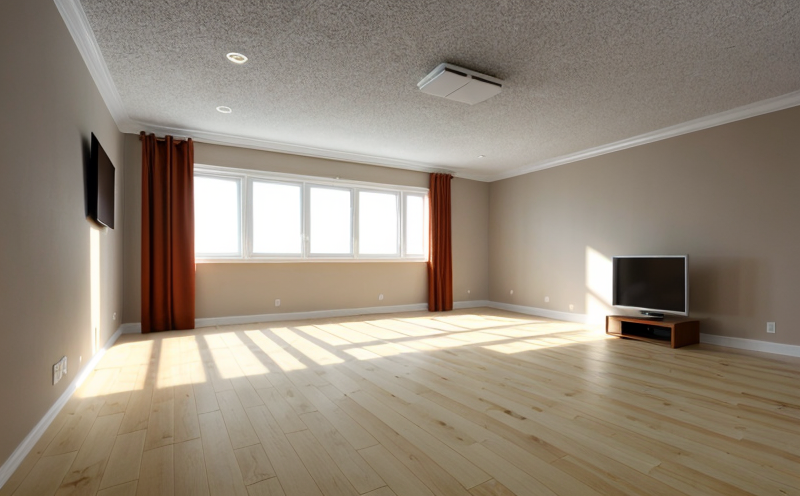ASTM E336 Field Measurement of Airborne Sound Insulation
The ASTM E336 standard specifies the procedures for conducting field measurements to evaluate airborne sound insulation. This service is crucial in ensuring that building materials and systems meet the required performance levels, particularly in environments where noise control is essential.
Field measurement involves assessing the ability of a partition (such as walls or floors) to reduce the transmission of airborne sound from one room to another. The test aims to quantify the level of sound reduction achieved by the partition under real-world conditions. This service is vital for compliance with building codes and standards, ensuring that new constructions or renovations meet necessary sound insulation requirements.
The ASTM E336 protocol includes several key aspects:
- Setting up test rooms to simulate a controlled environment
- Selecting appropriate sources and receivers of noise
- Measuring background noise levels in both source and receiving rooms
- Implementing the partition between the two rooms
- Conducting sound measurements with calibrated microphones placed at specified locations
- Analyzing the data to determine the sound reduction index (Ra)
The results of this test are used in various sectors including residential, commercial, and industrial buildings. For instance, in residential settings, it ensures that homes are quiet enough for occupants, while in healthcare facilities, it helps maintain privacy and reduce stress levels.
Understanding the ASTM E336 procedure is essential for quality managers, compliance officers, R&D engineers, and procurement specialists who work with acoustics, vibration, and noise testing. Familiarity with this standard ensures that materials and systems meet specified performance criteria, enhancing overall building performance and occupant comfort.
| Test Room Configuration | Measurement Points | Calibration Requirements |
|---|---|---|
| Source room and receiving room with appropriate partitions | Microphones placed at specific locations in both rooms | Calibrated to ensure accuracy of the measurements |
The ASTM E336 procedure is a cornerstone for any organization involved in the construction or renovation of buildings. It provides a standardized method for assessing sound insulation, ensuring that the final product meets the necessary performance criteria.
Industry Applications
The ASTM E336 field measurement of airborne sound insulation is widely used across various industries:
- Residential construction to ensure privacy and comfort
- Commercial buildings to enhance productivity and reduce noise pollution
- Healthcare facilities to maintain patient privacy and reduce stress levels
- Education institutions to improve learning environments
- Entertainment venues to control sound leakage
The test is also crucial in industrial settings where noise can affect worker health and safety. By ensuring that partitions meet the required performance criteria, ASTM E336 helps maintain a healthy work environment.
| Industry Sector | Specific Application |
|---|---|
| Residential Construction | Ensuring privacy and comfort in living spaces |
| Commercial Buildings | Enhancing productivity and reducing noise pollution |
| Healthcare Facilities | Maintaining patient privacy and reducing stress levels |
| Educational Institutions | Improving learning environments |
| Entertainment Venues | Controlling sound leakage |
| Industries | Maintaining a healthy work environment and ensuring worker safety |
The versatility of ASTM E336 makes it an indispensable tool for any organization involved in the construction or renovation of buildings. It ensures that the final product meets necessary performance criteria, enhancing overall building performance and occupant comfort.
International Acceptance and Recognition
The ASTM E336 field measurement of airborne sound insulation is widely recognized and accepted internationally for its reliability and accuracy in assessing sound insulation. It is referenced in various international standards, including ISO 140-4, which provides guidance on environmental noise issues.
- ISO 140-4: Provides guidelines for measuring sound insulation
- EN 323: Specifies the conditions under which airborne sound insulation can be determined using field measurement techniques
- ASTM E1876: Offers additional guidance on measuring sound insulation in buildings
The ASTM E336 procedure is not only widely used but also consistently recognized for its ability to provide accurate and reliable results. This standard ensures that buildings meet necessary noise control standards, contributing to a healthier living and working environment.
Environmental and Sustainability Contributions
The ASTM E336 field measurement of airborne sound insulation plays a crucial role in enhancing environmental sustainability by ensuring that buildings are designed and constructed with consideration for noise pollution. By reducing the transmission of unwanted sounds, this service helps create quieter, more comfortable environments for occupants.
Reducing noise pollution has numerous benefits:
- Improves sleep quality
- Maintains mental health by reducing stress levels
- Enhances productivity in workspaces
- Promotes better learning and teaching in educational institutions
- Supports the well-being of healthcare workers and patients
By ensuring that buildings meet noise control standards, ASTM E336 contributes to a healthier living and working environment. This reduces stress levels and enhances overall well-being.





